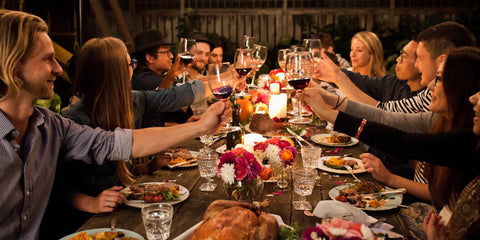Sharing Your Traditions: Thanksgiving Smoke

Thanksgiving 2017 finds us at a pivotal time in the fight for legal marijuana, and it is time to get vocal about it. Are you thankful for the gift of herbs and dry herb vaporizers? Then, this holiday season, consider sharing your stories about marijuana and its place in a healthy life. Don't be shy, don't hide it: This Thanksgiving, let's take marijuana taboos off the table, and create conversation about how it might help people who would benefit from its blessing. This doesn't have to be a difficult conversation... after all, vaporizing marijuana has been good for us. Sharing is a natural thing to do when we are happy, healthy, and wanting the same for others. So just how do you talk pot over the holidays?
Gratitude can have some powerful effects. As we raise a glass in toast of all our blessings and bounty, don't hesitate to call out ALL the good things in your life. If you are having success using marijuana medicinally and vaping, say so! Treating pain and anxiety with a remedy that is both natural and non-addictive deserves some attention. The changing tide that is beginning to sweep the nation makes this an excellent time for those who were once closed-minded to potentially rethink their bias. Don't be afraid to speak up and share your truth. Frame it as a toast: To health and happiness! You can avoid the arguments and hold the line, “Hey, vaping really working for me.” People love to hear about success.

Your gratitude may spark some lively conversation. Let it happen, with respect for differing opinions. Model “active listening” by showing that you hear and respect that people have their own experiences and gain insight into theirs. Sharing specific medical complaints might be something people prefer to do with a doctor or professional, so there might be boundary issues popping up. As you begin the conversation, have one goal: begin normalizing the conversation around vaporizers and marijuana and its place in our lives. You will probably never convince someone of something that they don't want to hear – yet you must remain open to understanding fears and facts that fuel other points of view. In the future sharing information you find specific to those misunderstandings or fears might make your relationship that much stronger.
Many people that we admire, even popular, cultural icons are discovering help for the same exact issues that we all face. Michael J. Fox has been an advocate for medical marijuana as it helps to treat Parkinson's disease. Patrick Stewart and Morgan Freeman both vaporize medical marijuana to treat chronic pain. Personal friends and community members who use marijuana can be powerful examples, too. It is becoming more and more common for someone to “have a friend” who has tried vaping dry herb with some success. Anxiety, epilepsy, depression, and glaucoma are all conditions that are being treated using medical marijuana. Listen and reiterate what you are hearing as encouragement to share more.
Trying something new is a little less foreign if we can create connections, but sharing personal treatment plans of local community members can be uncomfortable. Be respectful, and ask permission before talking out of turn when sharing about people you know. We are not talking about keeping taboos, but do be considerate of personal privacy. These conversations and revelations cannot be “unheard” and rumors are never good to circulate. Stick to facts and share about people who are willing to be contacted or whose stories are known to be OK to share. Sound like a lot of work? It's worth it. Dry herb vaporizers and making marijuana use a part of the conversation and tearing down the mystery about who is using it helps people to consider whether it might be something that they could at least try.
Don't be afraid to get specific. You might just be the first person that has real information about new ways of vaping. To Aunt Janice, the world of vaping, tinctures, edibles or dabbing could very well be a mystery. Your job is to find out if your friend or family member is discounting marijuana as a treatment because of ideas or misconceptions that have been developed over years. Illustrate the current research by talking about the difference between THC and CBD and how these compounds effect people who use marijuana. Many people don't realize how far-reaching and diverse the treatments can be, and that there are non-intoxicating ways to dose. Others have questions around dosing or managing the pleasant effects of marijuana. Some people feel fearful, worried about being “out of control”. Why would someone want to try something they've been told for years is “bad” for them? Help people to understand the controversial nature of classifying marijuana as a schedule 1 substance, and the difference between marijuana and other drugs in that category. It's good conversation, complete with history, politics and economics thrown in.

Misconceptions can be resolved with clear information and references that are accessible to the recipient (some older folks are less computer oriented, so maybe print articles or watch that YouTube video with them...) Bring the subject up at a good time for people to hear it, and be prepared to introduce the ideas repeatedly, over time, with new references and evidence. And don't just talk about the positives! Acknowledge the negative angles that people will inevitably bring up, and don't discount them. Kids eating pot and having horrible experiences, accidents caused by driving under the influence, pets overdosing – all are real things and deserve to be addressed. They don't have to close down a conversation, and they are separate from the conversation at hand: how marijuana can be a solution for so many real problems.
The conversations that begin over the holidays make you an envoy – someone who introduces an idea and gets people thinking. However, it is easy to get carried away. Let the patient decide if medical marijuana is something that they might explore further – remember, it's their body! Don't make it bigger than it is – adding your drama or passion about the benefits of vaporizing marijuana and dry herb vapes can cloud the waters when they are already in pain or experiencing fear. Your continued sharing can be light, simply providing access to your own life and how marijuana is part of your own success. Let it be a beacon that people choose to come to on their own.
In the happy event that your sharing has given a person some new insights and they are interested, it is important to know the next steps. It might be finding a medical professional who will consult with the patient, it might be applying a topical solution, or helping them understand the issues that they will need to resolve. If you begin the conversation, be ABLE to move it forward, if the patient is open to doing that. Offering gentle, supportive help is the best way to secure success for a previously clueless or fearful patient. Even if you are not the one with the information they need, but open to being with them through their journey to GET that information or next step.
Experimentation is one thing, but self medication is just that. In your enthusiasm, be careful about jumping in with a joint in hand, or edible on the plate. If you do, keep the person with you until the effects are clear and you are certain that your friend or family member is in a good place. When introducing marijuana in a medical context, you are usually NOT a professional, and shouldn't pretend to be one. If a person is on other medications or has a medical history that is unknown to you, introducing medical marijuana might be more complicated. Encourage responsible use. You might enable them to begin thinking and acting on some good ideas, but no one wants to be a drug “pusher”.

Support and follow up – Often people act impulsively. They might buy a product or tool, but not have the understanding to use it safely or effectively. If ingesting or smoking, vaping or experimenting, remind the patient to start slowly, and ensure that there is someone with them to see how they are affected by the medication. Sensations might be unusual or scary, dosing issues can confuse patients, and normal activities may seem different while “under the influence” of medication. Introducing ideas and then products, AND ensuring a person's safety is KEY (and part of the work you took up!). Take your responsibility seriously – the initial days and weeks might only be the beginning. Follow up.
Thanksgiving is a perfect time to get together, to share the good things in life with those you care about. We have a lot to be grateful for, and this year, talking about marijuana and dry herb vaporizers can make it all so much better.

